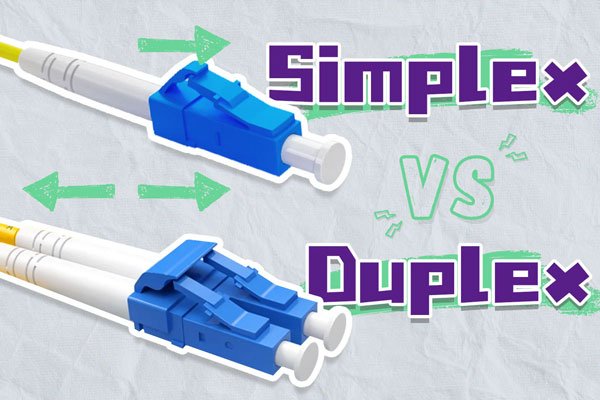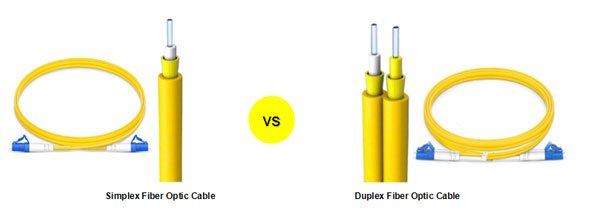Imagine simplex vs duplex fiber optic cables as two different gardening approaches—one plants a single row of flowers, blooming in one direction, while the other cultivates a paired bed, flourishing both ways. Fiber optic cables are the roots of our digital landscape, channeling data as light pulses to nourish everything from home internet to global communication networks. Simplex cables grow a single strand for one-way flow, while duplex cables nurture two strands for a reciprocal exchange. Picking between them is like choosing the right brush for a painting—each stroke shapes the final masterpiece.
In this comprehensive guide, we’ll dig into simplex vs duplex fiber optic cables—their structures, purposes, benefits, drawbacks, and how to select the best fiber optic connection for your setup. Think of it as crafting a recipe: you need the right ingredients for the dish. Let’s spade into the details and cultivate some clarity!
What Are Simplex vs Duplex Fiber Optic Cables?
The simplex vs duplex fiber optic cables distinction is like comparing a single-note melody to a two-part harmony—each has its own rhythm and resonance. Let’s unearth their foundations:

Simplex Fiber Optic Cables
- Definition: A simplex cable is a lone fiber encased in a protective jacket, designed for one-way transmission—like a single beam of sunlight feeding a plant.
- Specs: Features one core, typically G652D for long distances or G657A for bend tolerance, with a core size of 8-10 microns (single mode) or 50/62.5 microns (multimode).
- Role: Carries data in one direction only—a solo performance with no echo.
- Details: Often paired with simple connectors like SC or FC, it’s lightweight and streamlined for focused tasks.
Duplex Fiber Optic Cables
- Definition: A duplex cable binds two fibers together, either in one jacket or as a zipcord pair, crafted for two-way communication—like a pair of vines growing side by side.
- Specs: Two cores, using the same fiber types as simplex (e.g., G652D, G657A), often bundled for easy handling and symmetry.
- Role: Facilitates a send-and-receive duet—data flows both ways in tandem.
- Details: Commonly uses paired connectors like LC or SC duplex, built for interactive systems.
CommMesh grows both varieties—simplex for solo blooms, duplex for paired blossoms—all rooted in quality.
How Simplex vs Duplex Fiber Optic Cables Work
Grasping simplex vs duplex fiber optic cables is like understanding a painter’s technique—one brushstroke vs. a layered canvas. Here’s how they apply their craft:
Simplex Functionality
- How: A single fiber sends light from one end to the other—no return path. It’s a one-way signal, like a letter mailed without expecting a reply.
- Details: Relies on one optical transceiver—the sender at one end, the receiver at the other. Signal loss is minimal (e.g., 0.2 dB/km for single mode G652D), keeping the message clear.
- Example: A factory sensor reports temperature to a control unit—no feedback loop needed.
- Tech Note: Often tested with an OTDR to ensure signal integrity over its solo journey.
Duplex Functionality
- How: Two fibers collaborate—one transmits, the other receives—working simultaneously like a two-way radio.
- Details: Each end uses a transceiver handling both tx (transmit) and rx (receive), typically paired with LC or SC duplex connectors for seamless swaps. It’s full-duplex communication—both sides active at once.
- Example: A laptop downloads a file while uploading a status update—data flows in both directions without pause.
- Tech Note: Requires careful pairing to avoid tx/rx mismatches, often verified with dual OTDR scans.
Simplex paints a single line—duplex layers a full picture. CommMesh cables deliver both with precision.

Applications of Simplex vs Duplex Fiber Optic Cables
Each simplex vs duplex fiber optic cable has its garden patch—like ingredients in a chef’s pantry. Here’s where they nourish:
Simplex Applications
- Where: One-way systems—sensors, monitoring setups, broadcast streams.
- Why: No return data required—just send and done.
- Details: Common in industrial automation (e.g., a pressure sensor feeding data to a dashboard) or media distribution (e.g., satellite signals to receivers). It’s efficient for point-to-point delivery without clutter.
- Example: A weather buoy transmits ocean data to a shore station—no response expected.
- Context: Often used in legacy systems or where bandwidth is dedicated to a single flow.
Duplex Applications
- Where: Two-way networks—LANs, data centers, telecom hubs.
- Why: Full interaction—send and receive in harmony.
- Details: Powers everything from office internet (e.g., browsing and emailing) to server-client exchanges (e.g., cloud backups) and VoIP calls. It’s the backbone of modern connectivity, thriving in dynamic environments.
- Example: A smart home hub controls lights while receiving status updates—two-way chatter.
- Context: Essential for high-traffic setups where real-time dialogue is key.
CommMesh’s simplex feeds one-way needs—duplex fuels two-way growth, all blooming in stock.
Performance Comparison of Simplex vs Duplex Fiber Optic Cables
The simplex vs duplex fiber optic cables performance is like comparing a solo flute to a piano duet—each has its tone and tempo. Here’s the score:
Simplex Performance
- Speed: Equals duplex per fiber—e.g., 10G over OM3 multimode up to 300 m or 100G over single mode.
- Capacity: Limited to one-way—delivers a single stream, no overlap or return.
- Details: Attenuation stays low (0.2 dB/km single mode, 3 dB/km multimode), but it’s a one-note song—great for focused tasks, not multitasking.
- Fit: High-speed, one-direction roles—think data feeds or telemetry.
- Limitation: No simultaneous reverse flow—ideal where feedback isn’t needed.
Duplex Performance
- Speed: Same per strand—10G or 100G—but two fibers double the action.
- Capacity: Two-way doubles throughput—send and receive without waiting.
- Details: It matches simplex loss rates, but the full-duplex mode boosts efficiency, like a conversation without pauses. It’s built for busy, interactive networks.
- Fit: High-demand, two-way systems—LANs, server links, real-time apps.
- Advantage: Handles bidirectional traffic seamlessly—perfect for modern demands.
Simplex plays a clear solo—duplex strikes a rich chord. Choose by your network’s melody.

Cost Analysis of Simplex vs Duplex Fiber Optic Cables
The cost of the simplex vs. duplex fiber optic cables is like a grocery list—one apple vs. a pair of oranges. Here’s the breakdown:
Simplex Cost
- Range: $0.05-$0.15 per meter—lean and economical.
- Why: One fiber, simpler jacket—fewer materials, less labor.
- Details: Multimode OM1 at $0.05/m, single mode G657A at $0.12/m—affordable for basic needs. Add a connector (e.g., SC at $2-$5), and it’s still light.
- When: Budget-friendly one-way setups—sensors, feeds.
- Value: Cuts costs where two-way isn’t required.
Duplex Cost
- Range: $0.10-$0.30 per meter—double the fiber, double the investment.
- Why: Two cores, paired design—more glass, more processing.
- Details: OM4 duplex at $0.18/m, G657A2 duplex at $0.28/m—premium for dual action. Connectors (e.g., LC duplex at $5-$10) add a bit more.
- When: Two-way, performance-driven projects—networks, servers.
- Value: Worth it for interactive systems needing both directions.
CommMesh keeps it balanced—simplex from $0.05/m, duplex from $0.10/m.

Installation and Maintenance of Simplex vs Duplex Fiber Optic Cables
Installing simplex vs duplex fiber optic cables is like framing a picture—one photo or a collage. Here’s how they hang:
Simplex Installation
- Ease: Straightforward—one fiber to prep, terminate, and test.
- Details: Single fusion splice or connector (e.g., SC), one OTDR scan—quick alignment, minimal fuss. Tools like a cleaver and splicer make it a snap.
- Maintenance: Simple—inspect one strand, and clean one end with an alcohol wipe.
- Time: Faster—less to manage, ideal for small jobs.
Duplex Installation
- Ease: More intricate—two fibers to align, terminate, and verify.
- Details: Dual splices or connectors (e.g., LC duplex), two OTDR tests—match tx/rx pairs carefully to avoid crossed signals. It’s a two-step dance needing precision.
- Maintenance: Double duty—check both strands, clean both ends, watch for wear.
- Time: Slower—extra steps, but worth it for two-way flow.
Simplex frames fast—duplex takes care of, but CommMesh cables streamline both.
Compatibility with Connectors in Simplex vs Duplex Fiber Optic Cables
How simplex vs duplex fiber optic cables match connectors is like pairing spices with a dish—harmony matters. Here’s the fit:
Simplex Connectors
- Options: SC, FC, ST—solo stars.
- Details: SC’s push-pull ease, FC’s threaded precision, ST’s bayonet lock—one fiber, one connection. Each clicks into place with a single-strand device.
- Fit: Single-purpose gear—sensors, legacy systems.
- Use Case: A monitor receiving a feed via SC simplex.
Duplex Connectors
- Options: LC, SC duplex—twin talents.
- Details: LC’s compact clip binds two fibers in a snap; SC duplex doubles up—two-way sync made simple. They’re built for paired ports.
- Fit: Modern networks—switches, routers, servers.
- Use Case: A server linking to a switch with an LC duplex.
CommMesh’s simplex pairs with SC—duplex loves LC, all connector-ready.

Advantages and Disadvantages of Simplex vs Duplex Fiber Optic Cables
The simplex vs duplex fiber optic cables pros and cons are like sketching a portrait—one pencil vs. a full palette. Here’s the outline:
Simplex Pros and Cons
- Pros: Cheaper ($0.05-$0.15/m), easier install—one fiber, one expense.
- Cons: One-way only—no return path, limited scope.
- Details: Perfect for feeds (e.g., video streams), weak for chats (e.g., no server replies). It’s a minimalist’s dream—light and focused.
- Trade-Off: Saves cash but caps functionality.
Duplex Pros and Cons
- Pros: Two-way flow—send/receive at once, versatile.
- Cons: Pricier ($0.10-$0.30/m), more setup—double the effort.
- Details: Ideal for networks (e.g., LANs), overkill for feeds (e.g., unused return fiber). It’s a multitasker’s tool—robust but complex.
- Trade-Off: Costs more but opens doors.
Simplex sketches simply—duplex colors broadly. CommMesh has both for your canvas.
Comparing Simplex vs Duplex Fiber Optic Cables
Here’s a simplex vs duplex fiber optic cables blueprint—like a gardener’s chart:
| Type | Fibers | Direction | Cost ($/m) | Best For |
|---|---|---|---|---|
| Simplex | 1 | One-way | $0.05-0.15 | Sensors, streams |
| Duplex | 2 | Two-way | $0.10-0.30 | LANs, servers |
Your seed packet—plant by need and budget.
Conclusion: Simplex vs Duplex Fiber Optic Cables Made Simple
Picking the right simplex vs duplex fiber optic cables is like seasoning a stew—wrong choice, and it’s bland or overdone. A simplex cable in a two-way network is a wilted leaf—no reply, just silence, costing rewiring or lost data. A duplex in a one-way task is like extra spice—wasted effort and money on an unused strand. The right cable—simplex for solo streams, duplex for full exchanges—keeps your network thriving, costs balanced, and performance blooming. It’s the root of your digital harvest—choose with care.
CommMesh offers fiber optic cable types for every plot—simplex from $0.05/m, duplex with LC-ready pairs, all FC-certified and shipping in 7 days. Whether you’re sowing the best fiber optic connection or pruning your setup. Keep your data growing—solo or paired, we’ve got the cable to cultivate success!

